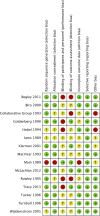Models of antenatal care to reduce and prevent preterm birth: a systematic review and meta-analysis
- PMID: 26758257
- PMCID: PMC4716175
- DOI: 10.1136/bmjopen-2015-009044
Models of antenatal care to reduce and prevent preterm birth: a systematic review and meta-analysis
Abstract
Objective: To assess the effectiveness of models of antenatal care designed to prevent and reduce preterm birth (PTB) in pregnant women.
Methods: We conducted a search of seven electronic databases and reference lists of retrieved studies to identify trials from inception up to July 2014 where pregnant women, regardless of risk factors for pregnancy complications, were randomly allocated to receive an alternative model of antenatal care or routine care. We pooled risks of PTB to determine the effect of alternative care models in all pregnant women. We also assessed secondary maternal and infant outcomes, women's satisfaction and economic outcomes.
Results: 15 trials involving 22,437 women were included. Pregnant women in alternative care models were less likely to experience PTB (risk ratio 0.84, 95% CI 0.74 to 0.96). The subgroup of women randomised to midwife-led continuity models of antenatal care were less likely to experience PTB (0.78, 0.66 to 0.91) but there was no significant difference between this group and women allocated to specialised care (0.92, 0.76 to 1.12) (interaction test for subgroup differences p=0.20). Overall low-risk women in alternative care models were less likely to have PTB (0.74, 0.59 to 0.93), but this effect was not significantly different from that in mixed-risk populations (0.91, 0.79 to 1.05) (subgroup p=0.13).
Conclusions: Alternative models of antenatal care for all pregnant women are effective in reducing PTB compared with routine care, but no firm conclusions could be drawn regarding the relative benefits of the two models. Future research should evaluate the impact of antenatal care models which include more recent interventions and predictive tests, and which also offer continuity of care by midwives throughout pregnancy.
Prospero registration number: CRD42014007116.
Keywords: OBSTETRICS; PUBLIC HEALTH.
Published by the BMJ Publishing Group Limited. For permission to use (where not already granted under a licence) please go to http://www.bmj.com/company/products-services/rights-and-licensing/
Figures






References
-
- World Health Organisation. Recommended definitions, terminology and format for statistical tables related to the perinatal period and use of a new certificate for cause of perinatal deaths. Modifications recommended by FIGO as amended October 14, 1976. Acta Obstet Gynecol Scand 1977;56:247–53. - PubMed
-
- World Health Organisation. Born Too Soon: The Global Action Report On Preterm Birth Geneva: WHO, 2012.
Publication types
MeSH terms
LinkOut - more resources
Full Text Sources
Other Literature Sources
Medical
